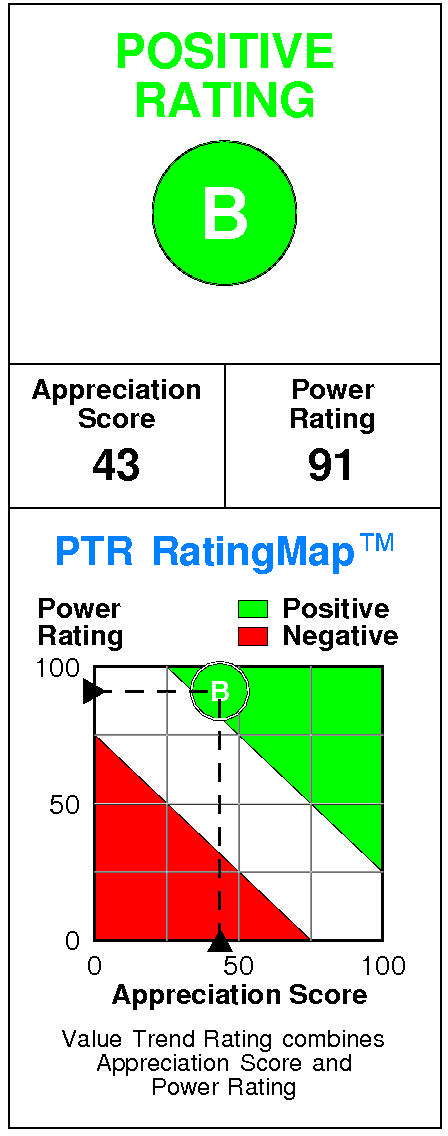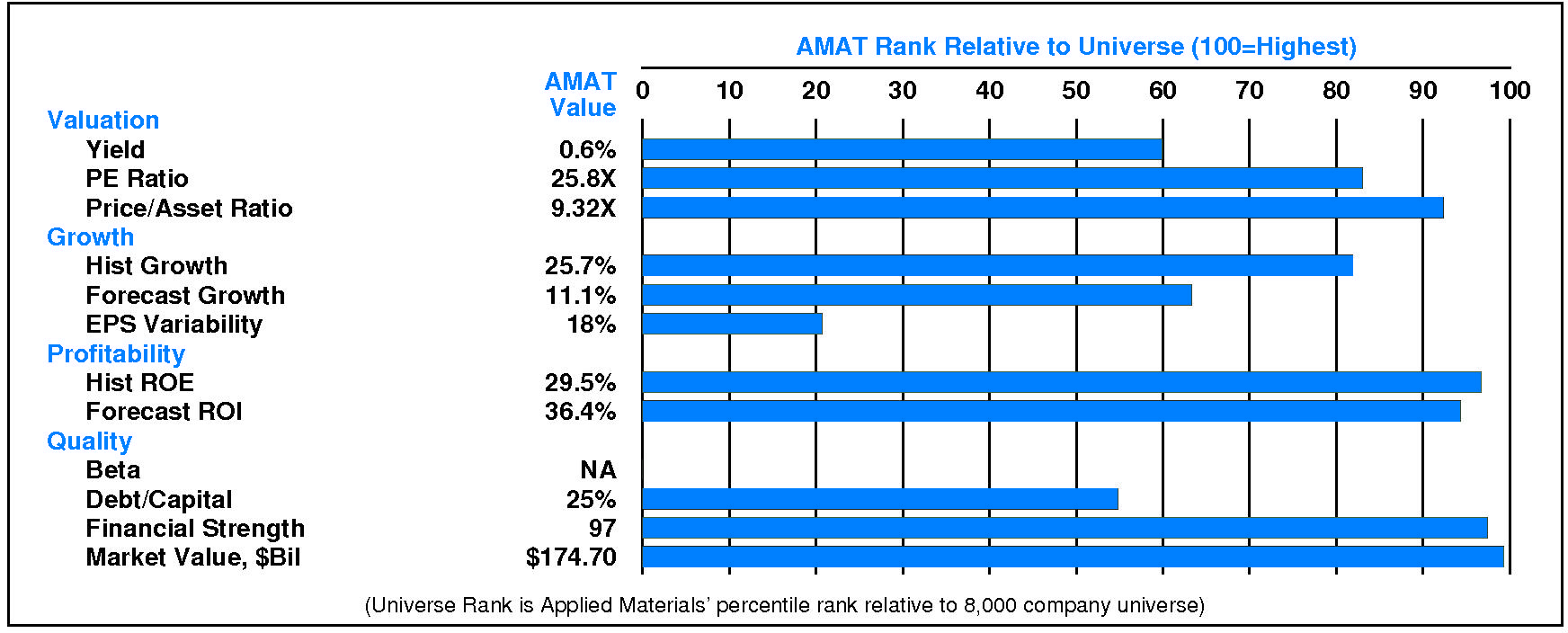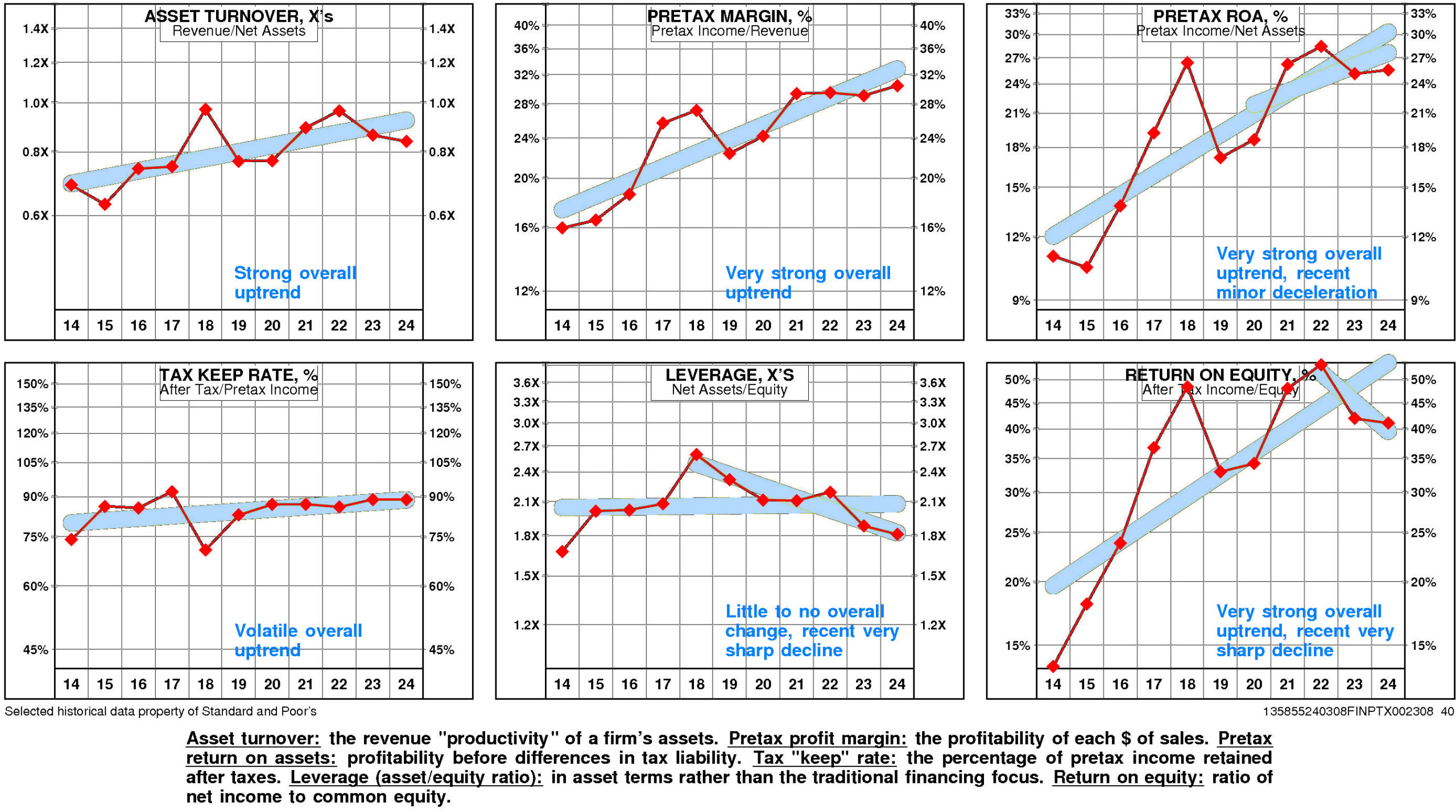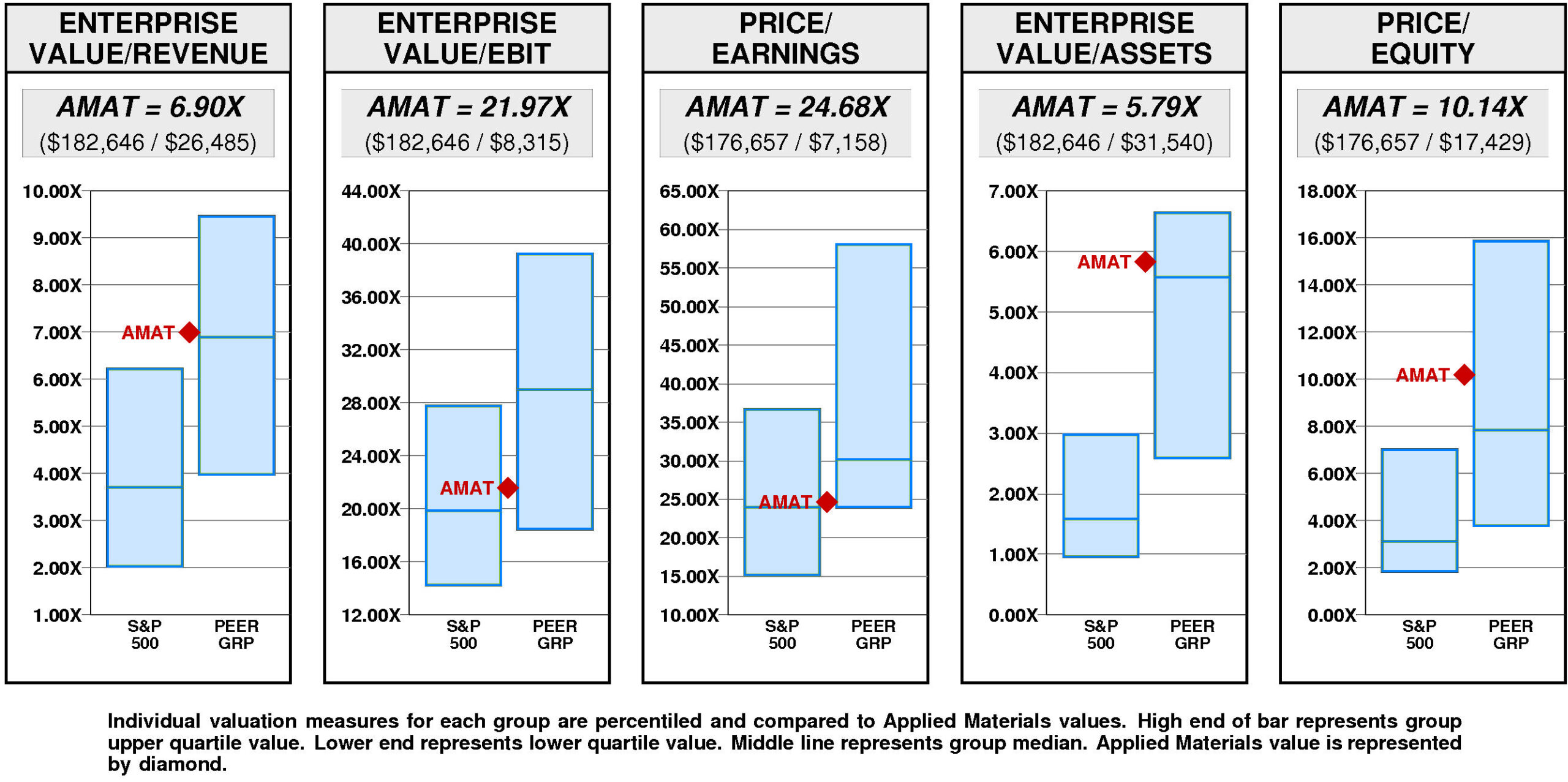
BUSINESS
Applied Materials, Inc. engages in the provision of manufacturing equipment, services, and software to the semiconductor, display, and related industries. It operates through three segments: Semiconductor Systems, Applied Global Services, and Display and Adjacent Markets. The Semiconductor Systems segment develops, manufactures, and sells various manufacturing equipment that is used to fabricate semiconductor chips or integrated circuits. This segment also offers various technologies, including epitaxy, ion implantation, oxidation/nitridation, rapid thermal processing, physical vapor deposition, chemical vapor deposition, chemical mechanical planarization, electrochemical deposition, atomic layer deposition, etching, and selective deposition and removal, as well as metrology and inspection tools.

INVESTMENT RATING

AMAT’s future returns on capital are forecasted to exceed the cost of capital. Accordingly, the company is expected to continue to be a major Value Builder.
Applied Materials has a current Value Trend Rating of B (Positive).
With this rating, PTR’s two proprietary measures of a stock’s current attractiveness are providing inconsistent signals. Applied Materials has a neutral Appreciation Score of 43 but a very high Power Rating of 91, producing the Positive Value Trend Rating.
Applied Materials’ stock is selling at targeted value. The current stock price of $212.61 compares to targeted value 12 months forward of $212.
This neutral appreciation potential results in an appreciation score of 43 (57% of the universe has greater appreciation potential.)

Applied Materials has a Power Rating of 91. (AMAT’s very high Power Rating indicates that it has a higher likelihood of achieving favorable investment performance over the near to intermediate term than all but 9% of companies in the universe.)
Factors contributing to this very high Power Rating include: the recent trend in AMAT’s earnings estimates has been extremely favorable; and recent price action has been extremely favorable. An offsetting factor is the Special Industry Machinery, NEC comparison group is in a slightly weakened position currently.
INVESTMENT PROFILE
AMAT’s financial strength is exceptional. Financial strength rating is 97.

Relative to the S&P 500 Composite, Applied Materials Inc has moderate Growth characteristics; its appeal is likely to be to Capital Gain-oriented investors; the perception is that AMAT is lower risk. All factors are relative strengths. AMAT’s valuation is high: low dividend yield, high P/E ratio, and high price/book ratio. AMAT has unusually high market capitalization.
CURRENT SIGNALS
Applied Materials’ current operations are eroding. Return on equity is falling, reflecting: and falling asset utilization.
Applied Materials’ current technical position is very strong. The stock price is in a 16.8 month up move. The stock has appreciated 181.0% from its prior low. The stock price is above its 200 day moving average which is in an uptrend.
ALERTS
Recent notable positive changes in fundamentals have benefitted Applied Materials Inc (NASDAQ: AMAT): the consensus estimate for October, 2025 increased significantly, the consensus estimate for October, 2024 increased significantly, and significant quarterly earnings acceleration occurred.
The stock is currently rated B.
Applied Materials Inc (NASDAQ: AMAT) stock closed at $212.61 on 3/7/24 after a slight gain of 0.2%. NORMAL trading volume accompanied the advance. The stock has risen 7.6% during the last week and has been exceptionally strong relative to the market over the last nine months.
CASH FLOW
In 2023, Applied Materials generated a very significant increase in cash of +$4,288 million (+166%). Sources of cash were much larger than uses. Cash generated from 2023 EBITDA totaled +$8,191 million. Non-operating sources contributed +$278 million (+3% of EBITDA). Cash taxes consumed -$901 million (-11% of EBITDA). Re-investment in the business amounted to -$511 million (-6% of EBITDA). On a net basis, debt investors withdrew -$68 million (-1% of EBITDA) while equity investors received -$2,701 million (-33% of EBITDA).

Applied Materials’ Non-operating Income, %EBITDA has exhibited little to no overall change over the period. This stability was accompanied by stability for the Applied Materials Peer Group as well. (Since 2021 Non-operating Income, %EBITDA has experienced sharp improvement.) In most years, Applied Materials was in the top quartile and third quartile. Currently, Applied Materials is upper quartile at +3% of EBITDA (+$278 million).
Applied Materials’ Cash Taxes, %EBITDA has exhibited little to no overall change over the period. This stability was accompanied by an uptrend for the Applied Materials Peer Group. In most years, Applied Materials was in the second quartile and top quartile. Currently, Applied Materials is at the upper quartile at -11% of EBITDA (-$901 million).
Applied Materials’ Business Re-investment, %EBITDA has experienced a downtrend over the period. This downtrend was accompanied by a similar trend for the Applied Materials Peer Group. In most years, Applied Materials was in the second quartile and third quartile. Currently, Applied Materials is substantially above median at -6% of EBITDA (-$511 million).
Applied Materials’ Debt Investors, %EBITDA has experienced a volatile overall downtrend over the period. This downtrend was accompanied by stability for the Applied Materials Peer Group. (Since 2021 Debt Investors, %EBITDA has experienced a small recovery.) In most years, Applied Materials was in the third quartile and top quartile. Currently, Applied Materials is above median at -1% of EBITDA (-$68 million).
Applied Materials’ Equity Investors, %EBITDA has exhibited little to no overall change over the period. This stability was accompanied by a downtrend for the Applied Materials Peer Group. In most years, Applied Materials was in the third quartile and second quartile. Currently, Applied Materials is above median at -33% of EBITDA (-$2,701 million).
Applied Materials’ Change in Cash, %EBITDA has experienced a volatile overall downtrend over the period. This downtrend was accompanied by a similar trend for the Applied Materials Peer Group. In most years, Applied Materials was in the top quartile and lower quartile. Currently, Applied Materials is at the upper quartile at +52% of EBITDA (+$4,288 million).

Applied Materials’ Cash, %Revenue has suffered a strong overall downtrend over the period. This downtrend was accompanied by a similar trend for the Applied Materials Peer Group. In most years, Applied Materials was in the third quartile and second quartile. Currently, Applied Materials is below median at +26%.
PROFITABILITY
Applied Materials’ return on equity has improved very significantly since 2014. The current level of 41.1% is 3.01X the low for the period and is -15.2% from the high.
This very significant improvement was due to very strong positive trend in pretax operating return and very minor positive trend in non-operating factors.
The productivity of Applied Materials’ assets rose over the full period 2014-2024: asset turnover has enjoyed a strong overall uptrend.
Applied Materials’ pretax margin enjoyed a very strong overall uptrend over the period 2014-2024.
Non-operating factors (income taxes and financial leverage) had a very small positive influence on return on equity.

Applied Materials’ return on equity is substantially above median (41.1%) for the four quarters ended January, 2024.

Operating performance (pretax return on assets) is upper quartile (25.5%) reflecting asset turnover that is at the upper quartile (0.84X) and pretax margin at the upper quartile (30.4%).
Tax “keep” rate (income tax management) is above median (88.8%) resulting in after tax return on assets that is upper quartile.
Financial leverage (leverage) is at median (1.81X).
GROWTH RATES
There are no significant differences between Applied Materials’ longer term growth and growth in recent years.
Applied Materials’ historical income statement growth and balance sheet growth have diverged. Revenue growth has paralleled asset growth; earnings growth has exceeded equity growth.
Annual revenue growth has been 16.8% per year.
Total asset growth has been 13.5% per year.
Annual E.P.S. growth has been 25.8% per year. (More recently it has been 8.3%.)
Equity growth has been 13.3% per year.
Applied Materials’ consensus growth rate forecast (average of Wall Street analysts) is 11.1% — substantially below the average of the historical growth measures.

Relative to the Applied Materials Peer Group, Applied Materials’ historical growth measures are erratic. Revenue growth (16.8%) has been at the upper quartile. E.P.S. growth (25.8%) has been at the upper quartile. Equity growth (13.3%) has been above median. Total asset growth (13.5%) has been slightly above median.
Consensus growth forecast (11.1%) is substantially below median.

PRICE HISTORY
Over the full time period, Applied Materials’ stock price performance has been exceptional. Between May, 2013 and March, 2024, Applied Materials’ stock price rose +1299%; relative to the market, this was a +342% gain. Significant price moves during the period: 1) September, 2022 – March, 2024: +160%; 2) March, 2020 – December, 2021: +243%; and 3) September, 2015 – February, 2018: +292%.

TOTAL INVESTMENT RETURNS
Current annual total return performance of 75.0% is upper quartile relative to the S&P 500 Composite.
In addition to being upper quartile relative to S&P 500 Composite, current annual total return performance through February, 2024 of 75.0% is upper quartile relative to Applied Materials Inc Peer Group.
Current 5-year total return performance of 40.9% is upper quartile relative to the S&P 500 Composite.
Through February, 2024, with upper quartile current 5-year total return of 40.9% relative to S&P 500 Composite, Applied Materials’ total return performance is upper quartile relative to Applied Materials Inc Peer Group.

VALUATION BENCHMARKS
Relative to S&P 500 Composite, AMAT’s overall valuation is quite high. The highest factor, the ratio of enterprise value/assets, is upper quartile. Price/equity ratio is upper quartile. Ratio of enterprise value/revenue is upper quartile. Ratio of enterprise value/earnings before interest and taxes is above median. The lowest factor, the price/earnings ratio, is slightly above median.
Relative to Applied Materials Peer Group, AMAT’s overall valuation is normal. The highest factor, the price/equity ratio, is above median. Ratio of enterprise value/assets is slightly above median. Ratio of enterprise value/revenue is at median. Price/earnings ratio is near the lower quartile. The lowest factor, the ratio of enterprise value/earnings before interest and taxes, is below median.

Applied Materials has a major value gap compared to median valuation. For AMAT to fall to lower quartile valuation, its current ratio of enterprise value/revenue would have to decline from the current level of 6.90X to 3.98X. If AMAT’s ratio of enterprise value/revenue were to decline to 3.98X, its stock price would be lower by $-93 to $120.
For AMAT to achieve upper quartile valuation relative to the Applied Materials Peer Group, its current ratio of enterprise value/revenue would have to rise from the current level of 6.90X to 9.46X. If AMAT’s ratio of enterprise value/revenue were to rise to 9.46X, its stock price would increase by $82 from the current level of $213.
VALUE TARGETS
AMAT’s future returns on capital are forecasted to exceed the cost of capital. Accordingly, the company is expected to continue to be a major Value Builder.
Applied Materials’ current Price Target of $247 represents a +16% change from the current price of $212.61.
This neutral appreciation potential results in an appreciation score of 43 (57% of the universe has greater appreciation potential.)
With this neutral Appreciation Score of 43, the high Power Rating of 91 results in an Value Trend Rating of B.

Applied Materials’ current Price Target is $247 (+21% from the 2023 Target of $204 and +16% from the 03/07/24 price of $212.61). This slight rise in the Target is the result of a +30% increase in the equity base and a -7% decrease in the price/equity multiple. The forecasted increase in growth has a slight positive impact on the price/equity multiple and the forecasted decline in cost of equity has a very slight positive impact as well. More than offsetting these Drivers, the forecasted decline in return on equity has a large negative impact.


PTR’s return on equity forecast is 36.8% — significantly below our recent forecasts. Forecasted return on equity enjoyed a dramatic, erratic increase between 2015 and 2023. The current forecast is significantly below the 2018 peak of 56%.
PTR’s growth forecast is 18.0% — in line with our recent forecasts. Forecasted growth enjoyed a dramatic, steady increase between 2015 and 2023. The current forecast is significantly above the 2016 low of 3%.
PTR’s cost of equity forecast is 13.1% — in line with recent levels. Forecasted cost of equity suffered a dramatic, erratic increase between 2015 and 2023. The current forecast is well above the 2015 low of 7.9%.

At Applied Materials’ current price of $212.61, investors are placing a positive value of $154 on its future investments. This view is consistent with the company’s most recent performance that reflected a growth rate of 17.0% per year, and a return on equity of 40.5% versus a cost of equity of 13.3%.
PTR’s 2025 Price Target of $247 is based on these forecasts and reflects an estimated value of existing assets of $85 and a value of future investments of $162.

Be the first to comment